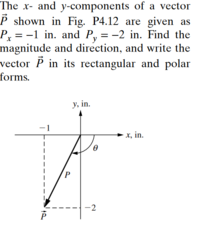coooool222
Junior Member
- Joined
- Jun 1, 2020
- Messages
- 93
The [imath]x[/imath]- and [imath]y[/imath]-components of a vector [imath]\overrightarrow{P}[/imath] are given as [imath]P_x = -1\textrm{ in.}[/imath] and [imath]P_y = -2\textrm{ in.}[/imath] Find the magnitude and direction, and write the vector [imath]\overrightarrow{P}[/imath] is its rectangular and polar forms.

So i found the magnitue which is
(-1)^2 + (-2)^2 = P^2 =
Sqrt(5)
Then I used the inverse tan function to find the angle (direction)
theta = arctan (-2/-1) = 63.8 degrees
Im confused with my 63.8 degrees since the angle in the graph looks greater than 63.4 degrees
I subtracted 180 by 63.8 and got 116.6
Since it's going clock wise it's -116.6
Am i right?

So i found the magnitue which is
(-1)^2 + (-2)^2 = P^2 =
Sqrt(5)
Then I used the inverse tan function to find the angle (direction)
theta = arctan (-2/-1) = 63.8 degrees
Im confused with my 63.8 degrees since the angle in the graph looks greater than 63.4 degrees
I subtracted 180 by 63.8 and got 116.6
Since it's going clock wise it's -116.6
Am i right?
Last edited by a moderator:
